 Facebook
Facebook
 X
X
 Instagram
Instagram
 TikTok
TikTok
 Youtube
Youtube
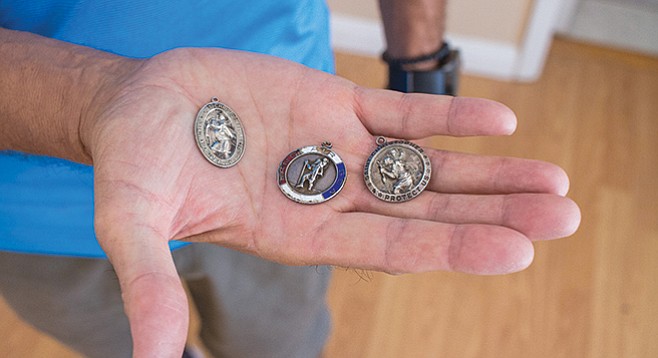
Antonio Palma felt something or someone was driving him to visit Vietnam, a place to which he had no ties. Not knowing what awaited him and traveling to the other side of the world without his St. Christopher medal made him uneasy.
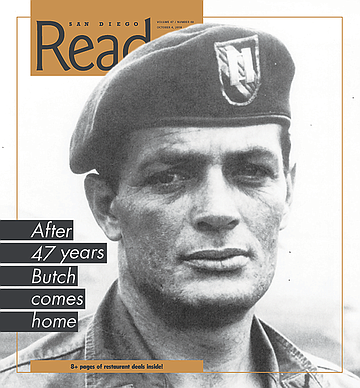
The religious medal, a gift from his grandparents, had been stolen weeks earlier after a day of surfing. He settled on buying a replacement in Ho Chi Minh City (Saigon) after he and his traveling companion landed.
The silver medal Palma purchased on that 1996 trip at a used goods store thrust him into the controversial case of a missing U.S. soldier from the Vietnam War. The affair ended in May 2018 when the American warrior was finally brought home and laid to rest, 47 years after he went missing and 22 years after Palma’s journey.
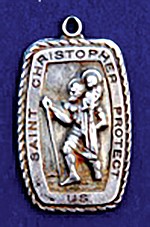
Patron saint of travelers
It was tarnished and oxidized by sweat. The raised areas of the effigy of St. Christopher — patron of travelers — were worn smooth. The back side of the rectangular piece was flat and blotchy with a dedication inscribed lengthwise on three lines that read “To Butch. Love Frances. Dec. 25, 1967.” The store owner said it belonged to an American soldier but Palma was not so sure. He paid $20 for it.
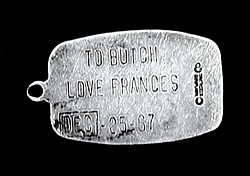
Palma, a 61-year-old Mission Hills resident, describes himself as a spiritual person and a believer, though he admits to “some problems” with the Catholic Church. The lost St. Christopher medal was a gift for his First Holy Communion when he was seven. He is Italian-Irish from Boston with an East Coast accent that is sometimes difficult to understand.

When the Vietnamese shopkeeper turned the medal over to show him the inscription, he read it carefully. The words provoked some unsettling questions for which he did not have answers. Who is Butch? Was he an American soldier? How did his religious medal end up for sale in a ramshackle store that sold what most American tourists saw as junk? What happened to him? Did he survive the war?
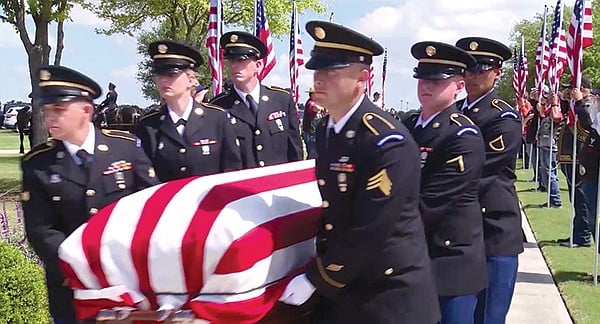
The questions of life and death merged with a painful reminder of two recent tragedies in Palma’s family. He was still grieving his brother, who was murdered in front of his home, and a brother-in-law who died from AIDS. His grief had been interwoven with bizarre thoughts about Vietnam that began after returning to San Diego from the last funeral. Why Vietnam? It was a confusing siren call that had played inside his head for about three months.
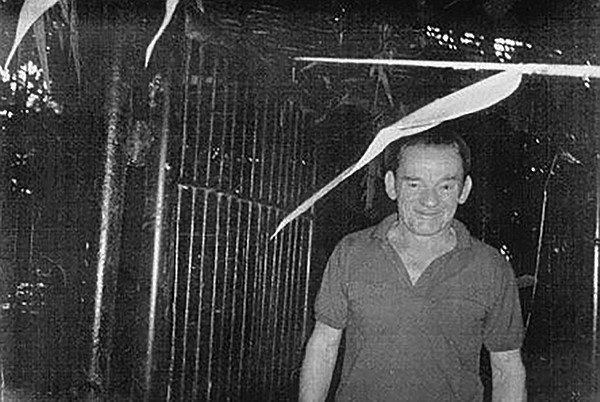
“I had no connection to the war. I never even served in the military. I graduated from high school in 1974 after the draft ended and never really gave Vietnam any thought,” he said in a meeting with a reporter at a Hillcrest bakery.
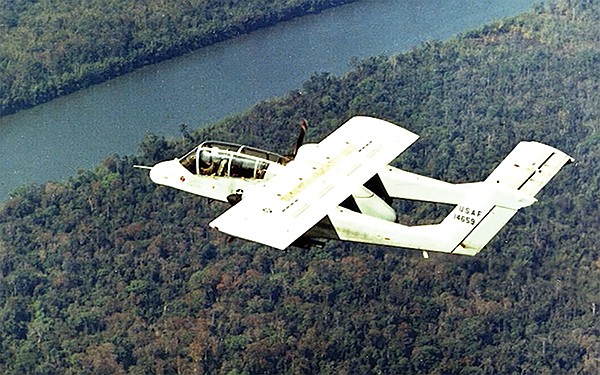
Palma, a hair stylist for 40 years, owned A Cut Above, a salon in Pacific Beach in the 1990s. The travel agency next door had two new owners and one day they came over to introduce themselves. They said they specialized in trips to Vietnam.
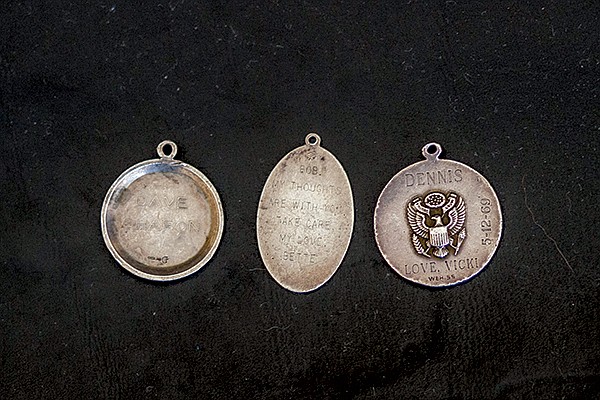
“Once I heard that I said, “I’m in.” That was a sign. I called my friend and he said he was in, too. For the first time in my life I followed my intuition. I had to go to Vietnam. After buying Butch’s medal, I understood why Vietnam. I had to find Butch or his family and return the St. Christopher medal. That’s why I had to go,” said Palma.
It was the beginning of a 17-year odyssey to learn Butch’s identity and locate him or his family. “It was not a pleasant ride,” Palma said. In the process, he was dismissed as a “scammer” by just about everyone he approached for help, including some veterans groups.
“I just wanted to return the medal. If the medal had belonged to my father I would’ve wanted it back,” he said. He finally returned it in the fall of 2013 after the veterans group Together We Served gave him a lead that Army Special Forces Major Donald Gene Carr, missing since 1971, was nicknamed Butch. Carr and Air Force First Lt. Daniel Thomas had disappeared while flying in an OV10 Bronco over the Ho Chi Minh Trail. But even after learning Carr’s name, convincing his family to accept his St. Christopher medal was not an easy task. His widow and adopted son showed no interest in Carr’s devotional icon, and a cousin whose mother had given Carr the medal on his first Vietnam tour was skeptical of Palma.
Harrowing experiences
Don Carr, a native of East Chicago, Indiana, served three years in Vietnam with MACV-SOG (Military Assistance Command Vietnam, Studies and Observations Group) beginning in 1966. SOG, as it was commonly known, was a super secret unit composed mostly of Army Green Berets who did covert missions targeting North Vietnamese Army units in Cambodia, Laos and North Vietnam. The innocuous sounding Studies and Observations Group belied the nature of the deadly missions conducted by SOG reconnaissance teams, which typically consisted of three Green Berets and up to a dozen indigenous troops. Missions were launched from Special Forces camps throughout South Vietnam.
SOG teams suffered heavy casualties, perhaps never greater than in 1968 when the unit suffered 100-percent casualties. Every SOG trooper was killed, wounded at least once, or went missing in action that year. SOG veteran John L. Plaster wrote in his book SOG that the unit suffered more than 300 losses, 57 of them missing in action, during the war. John Stryker Meyer, a former San Diego Union reporter, North County Times editor and a SOG veteran, chronicled his harrowing experiences with Recon Team Idaho (also known as Spike Team Idaho) in Across the Fence.
By all accounts Carr was an exceptional combat soldier. He earned a Silver Star, four Bronze Stars, and a Purple Heart. After several months of combat, he was assigned a desk job planning and evaluating missions at SOG headquarters in Saigon alongside Capt. Michael Taylor. Soon after, Taylor was reassigned to the secret SOG base at Nakhon Phanom Airfield in Thailand, where his duties included flying back seat reconnaissance missions over the Ho Chi Minh Trail in an OV10 flown by an Air Force officer.
After a year at his Thailand assignment, Taylor was ordered to report to SOG’s Command and Control Central in South Vietnam where he was to be operations officer. The central command ran missions in the tri-border area of Cambodia, Laos, and South Vietnam. Carr was assigned as his replacement at Nakhon Phanom in late June 1971. Taylor helped Carr get acquainted with his new assignment over a week’s time. On July 6, 1971 he drove Carr to the airfield for his final mission with the pilot Daniel Thomas. Several air searches in the following days failed to uncover any signs of the downed aircraft.
“They never returned. A recon team later reported hearing a loud explosion near their location.... The weather was very bad and the terrain mountainous, so collision with a mountain could not be ruled out,” Taylor said at his friend’s memorial service on May 11 in San Antonio.
Taylor described Carr as a “courageous commander” who led from the front and cared for his soldiers. He was “a consummate professional” who was “liked, admired, and respected by everyone who knew him.”
Wrong country
After the initial search for Carr and Thomas, the Department of Defense did not revisit their case until 1991 when a self-described POW hunter from Orange County made an explosive claim that he had photographic proof that Carr was alive and being held in a Laotian jungle prison. Jack Bailey, a former Air Force pilot who headed the POW group Operation Rescue, released the Carr photo to the press. It was a picture of a middle-aged man who appeared to be in a cage and bore a remarkable resemblance to Carr. Bailey, who is dead, was a controversial figure accused by critics of raising money by raising the hopes of MIA families whose loved ones were unaccounted for.
Carr’s ex-wife, Carol Collins, who is deceased, traveled to Thailand with Bailey hoping to meet with a Laotian official who had provided the photo. The mysterious official was supposed to help them contact Carr. Of course, that never happened. Later, when it was revealed that the man in the photo was a German bird smuggler named Gunter Dittrich, Collins flew to Germany to meet with him to remove any doubt about who he was and quickly determined he was not Carr.
Bailey’s story had already unraveled before Collins’ trip to Germany. In 1992 ABC News exposed the photo as a fraud and millions of viewers watched Bailey attack a reporter when he was confronted with the evidence. Dittrich had been photographed in Bangkok instead of a jungle prison camp in Laos.
However, the photo caused the Senate to convene the Select Committee on POW/MIA Affairs shortly after its release in the summer of 1991. The Senate was forced to act in part because of pressure from the politically active POW/MIA movement which charged that the U.S. government had knowingly left U.S. servicemen behind and was involved in a cover-up. The committee’s job was to investigate Carr’s case and those of other servicemen who might still be imprisoned 18 years after the release of U.S. prisoners by North Vietnam. It was chaired by Senator John Kerry, a Vietnam combat veteran, and former POW Senator John McCain was a member.
Collins, who had already divorced Carr when he went missing, and loved ones of other missing servicemen testified before the committee in hearings broadcast by CSPAN.
Charles L. Prichard, spokesman for the Defense POW/MIA Accounting Agency, said in an email that the agency launched 18 investigations to recover Carr’s remains beginning in 1991. Unfortunately, the search was concentrated in the wrong country, Laos.
It took an incredible chain of happenstance and characters to find Carr and bring him home and to find and return the St. Christopher medal that offered solace to him. Palma persisted in his nearly 20-year mission to honor Carr’s memory even when his overture was rejected by the missing man’s family.
Palma would not quit
Palma set up a blog (since taken down) with photos of Carr’s St. Christopher medal and three others that he purchased that also had names engraved on the back. He sent out a press release with information about the medals, misidentifying Frances as Francis, but did not get a response. Undeterred, he thought his best chance of finding an owner lay with the medal given to Butch.
After learning from the veterans’ group Together We Served that Carr’s nickname was Butch, he Googled his name and saw his face for the first time.
“Everyone was telling me that [the Vietnamese] were making these fake medals; to forget about it it was some kind of a scam and I was going to be caught up in it. But when I saw Butch’s picture I was so excited and knew I was on the right track,” said Palma.
In 2001, Mary Schantag, who founded the POW/MIA Network with her late husband Chuck, came across Palma’s blog and alerted Carr’s cousin, Karen Kirkpatrick. “Did Butch know anyone named Francis (sic)? Did he wear a St. Christopher medal?” she wrote in an email. Kirkpatrick replied “Butch also wore a St. C medal and my mother’s name was Francis” (sic — the spelling for the male version of the name.) Kirkpatrick had been involved in the POW/MIA movement and worked on Carr’s case. Efforts to contact her for this story were unsuccessful. She did not respond to emails and could not be reached by telephone.
In March 2001, Kirkpatrick emailed Palma and noted that Carr was still missing. “We are still fighting to find out what happened and possibly where he is.... My mother, Butch’s only paternal aunt was named Francis (sic). I do not know if the medal is the one she gave Butch, but I must inquire,” she wrote.
Palma was in the process of moving when he received Kirkpatrick’s email. He printed the missive and filed it in a box and deleted the email. He did not find the misplaced email until 2013 and responded to the 12-year-old query from Kirkpatrick. The lengthy delay made her wary of Palma, which was obvious in their telephone conversations.
“She pretty much said she didn’t trust me. She was skeptical and asked me a lot of questions about my background and started going into the whole conspiracy thing about soldiers being left behind [in jungle prison camps] and the government covering things up,” said Palma. She told him that Carr had a son named Donald Gene Carr, Jr.
Palma turned to the Defense Department’s POW/MIA Accounting Command in Hawaii for help in locating the son. “I’m looking for Major Carr’s son Donald Gene Carr Jr. as one of the family members to return the medallion [to],” he wrote in an April 2013 email. In an earlier email to the command he said he had learned that Carr’s widow was Carol Collins.
An April 22, 2013 email from the agency advised Palma that an Army Casualty Officer had contacted Carr, Jr. and Collins and asked if they were interested in talking to him but they did not respond to two messages left for them. On May 21 Palma received another email from the POW/MIA Accounting Command saying, “After several attempts the Army has still not heard anything back from Major Carr’s family concerning your wishes to return to them a St. Christopher medal you believe may have belonged to their loved one.”
Palma would not quit. He contacted Kirkpatrick again, still determined to return the St. Christopher medal to the family. After six months of emails and phone calls, Kirkpatrick agreed to accept the medal. “Medal finally arrived Friday. My sister and I are planning to get together this week to open the box,” she wrote in an Oct. 27, 2013 email. She later sent Palma a photo of the St. Christopher medal in a special display case in her home.
“I was passionate about it. I was not going to give up, not when I knew the medal belonged to Butch. I had seen his face. I knew who he was. How could I not do this,” said Palma.
Palma’s mission was completed but Carr was still unaccounted for. Taylor and the other SOG veterans he served with knew full well that their comrade’s remains lay somewhere in a Southeast Asia jungle.
My moral duty
Owen Bell, a Canadian who lives in Vietnam and runs tours off the beaten track, met a Vietnamese national in March 2014 near Kham Duc, site of an old Special Forces camp and a disastrous 1968 battle. Bell is married to a Vietnamese woman and is a legal permanent resident of Vietnam. In a recent telephone interview, Bell said the man, perhaps thinking he was an American, casually pulled out his wallet and showed him a photo of Carr’s dog tag, which identified him as Catholic.
“He started telling me about the American in the mountains... I took a picture of him and a picture of the dog tag. Then he says, ‘Do you want to meet the guys who found him?’ He said they lived in a village in the mountains [close by].” The man took out his cell phone and called them.
They agreed to meet at the coffee shop at the hotel where Bell was staying. He Googled Carr while he waited and learned about his case and that Thomas was also missing. A couple of hours later three Montagnards — an ethnic minority group in Vietnam’s central highlands — joined Bell and the other man. Bell, who became consumed by Carr and blogged about his accidental involvement with the American’s case, refers to him by his first name “out of respect for this American warrior.” He wrote on his blog that he had “no idea how profoundly [Carr] would affect his life.”
“We started talking about Donald and they pulled out his dog tag and a small American flag [taken from the crash site]. They said they would go back to the crash site and get parts of his uniform. I said no,” Owen said.
The Montagnards had found the plane on the side of a mountain three or four years earlier while hunting but kept it a secret for fear of Vietnamese government reprisals. Over the years they scavenged and sold parts of the aircraft, which burned, and otherwise left Carr’s remains where they found them.
Carr was lying about 10 meters from the aircraft, which Prichard confirmed, suggesting that he may have been ejected when the plane crashed. The Montagnards said they did not find Thomas’ remains.
Bell attempted to notify the POW/MIA Accounting Agency’s predecessor, the Joint POW/MIA Accounting Command, at their Hanoi office but never received a reply to his emails. Meanwhile, the Vietnamese who led him to the three Montagnards who found the crash said he wanted $240,000 from the U.S. government in exchange for revealing the site. Prichard said that “as a matter of policy” the U.S. does not pay for remains.
In April 2014, one month after meeting the Montagnards, Bell asked a Vietnamese friend with ties to Joint POW/MIA Accounting Command in Hanoi to notify the agency that Carr had been found.
“The [Vietnamese] citizen told the U.S. personnel... that he and several other residents had found aircraft wreckage in a jungle in Kon Tum Province [Vietnam],” said Prichard. He added that the men “did not receive any compensation.”
Carr’s remains were received at the Department of Defense lab in Hawaii on September 12, 2014, five months after the DOD learned the crash site location, and positive identification through DNA testing was made on August 19, 2015. Why it took nearly three years to bring him home and bury him is unclear.
Meanwhile, Thomas remained missing. It took two years before Vietnamese authorities returned to excavate the crash site in April and May 2016 and found his identification tag and dental remains in the burnt wreckage. He was positively identified in February 2017 and buried in his hometown of Danbury, Nebraska, population 140, in November. Incredibly, tiny Danbury suffered three MIAs in the Vietnam War. Each man was an Air Force pilot. One is still missing.
“As a Canadian I felt responsible to report Donald to the U.S. authorities. It was my moral duty to help return Donald to his family,” said Bell.
Palma was not aware that Carr had been returned to the U.S. and buried last summer in Texas; laid to rest with military honors by some of his SOG comrades and current members of the U.S. Army Special Forces.
“Butch is home just like his St. Christopher medal,” he said with a beaming a smile. How Carr got separated from his religious medal remains unknown.
There are 1597 Americans unaccounted for in Southeast Asia. Four hundred seventy are categorized as non-recoverable, in many cases this means all trace of them has disappeared.
H.G. Reza is a retired Los Angeles Times journalist. He served with MACV Team 3 from 1967 to 1968 on a six-man U.S. Army advisory team that lived and fought with a South Vietnamese Popular Forces company.


Antonio Palma felt something or someone was driving him to visit Vietnam, a place to which he had no ties. Not knowing what awaited him and traveling to the other side of the world without his St. Christopher medal made him uneasy.

The religious medal, a gift from his grandparents, had been stolen weeks earlier after a day of surfing. He settled on buying a replacement in Ho Chi Minh City (Saigon) after he and his traveling companion landed.
The silver medal Palma purchased on that 1996 trip at a used goods store thrust him into the controversial case of a missing U.S. soldier from the Vietnam War. The affair ended in May 2018 when the American warrior was finally brought home and laid to rest, 47 years after he went missing and 22 years after Palma’s journey.

Patron saint of travelers
It was tarnished and oxidized by sweat. The raised areas of the effigy of St. Christopher — patron of travelers — were worn smooth. The back side of the rectangular piece was flat and blotchy with a dedication inscribed lengthwise on three lines that read “To Butch. Love Frances. Dec. 25, 1967.” The store owner said it belonged to an American soldier but Palma was not so sure. He paid $20 for it.

Palma, a 61-year-old Mission Hills resident, describes himself as a spiritual person and a believer, though he admits to “some problems” with the Catholic Church. The lost St. Christopher medal was a gift for his First Holy Communion when he was seven. He is Italian-Irish from Boston with an East Coast accent that is sometimes difficult to understand.

When the Vietnamese shopkeeper turned the medal over to show him the inscription, he read it carefully. The words provoked some unsettling questions for which he did not have answers. Who is Butch? Was he an American soldier? How did his religious medal end up for sale in a ramshackle store that sold what most American tourists saw as junk? What happened to him? Did he survive the war?

The questions of life and death merged with a painful reminder of two recent tragedies in Palma’s family. He was still grieving his brother, who was murdered in front of his home, and a brother-in-law who died from AIDS. His grief had been interwoven with bizarre thoughts about Vietnam that began after returning to San Diego from the last funeral. Why Vietnam? It was a confusing siren call that had played inside his head for about three months.

“I had no connection to the war. I never even served in the military. I graduated from high school in 1974 after the draft ended and never really gave Vietnam any thought,” he said in a meeting with a reporter at a Hillcrest bakery.

Palma, a hair stylist for 40 years, owned A Cut Above, a salon in Pacific Beach in the 1990s. The travel agency next door had two new owners and one day they came over to introduce themselves. They said they specialized in trips to Vietnam.

“Once I heard that I said, “I’m in.” That was a sign. I called my friend and he said he was in, too. For the first time in my life I followed my intuition. I had to go to Vietnam. After buying Butch’s medal, I understood why Vietnam. I had to find Butch or his family and return the St. Christopher medal. That’s why I had to go,” said Palma.
It was the beginning of a 17-year odyssey to learn Butch’s identity and locate him or his family. “It was not a pleasant ride,” Palma said. In the process, he was dismissed as a “scammer” by just about everyone he approached for help, including some veterans groups.
“I just wanted to return the medal. If the medal had belonged to my father I would’ve wanted it back,” he said. He finally returned it in the fall of 2013 after the veterans group Together We Served gave him a lead that Army Special Forces Major Donald Gene Carr, missing since 1971, was nicknamed Butch. Carr and Air Force First Lt. Daniel Thomas had disappeared while flying in an OV10 Bronco over the Ho Chi Minh Trail. But even after learning Carr’s name, convincing his family to accept his St. Christopher medal was not an easy task. His widow and adopted son showed no interest in Carr’s devotional icon, and a cousin whose mother had given Carr the medal on his first Vietnam tour was skeptical of Palma.
Harrowing experiences
Don Carr, a native of East Chicago, Indiana, served three years in Vietnam with MACV-SOG (Military Assistance Command Vietnam, Studies and Observations Group) beginning in 1966. SOG, as it was commonly known, was a super secret unit composed mostly of Army Green Berets who did covert missions targeting North Vietnamese Army units in Cambodia, Laos and North Vietnam. The innocuous sounding Studies and Observations Group belied the nature of the deadly missions conducted by SOG reconnaissance teams, which typically consisted of three Green Berets and up to a dozen indigenous troops. Missions were launched from Special Forces camps throughout South Vietnam.
SOG teams suffered heavy casualties, perhaps never greater than in 1968 when the unit suffered 100-percent casualties. Every SOG trooper was killed, wounded at least once, or went missing in action that year. SOG veteran John L. Plaster wrote in his book SOG that the unit suffered more than 300 losses, 57 of them missing in action, during the war. John Stryker Meyer, a former San Diego Union reporter, North County Times editor and a SOG veteran, chronicled his harrowing experiences with Recon Team Idaho (also known as Spike Team Idaho) in Across the Fence.
By all accounts Carr was an exceptional combat soldier. He earned a Silver Star, four Bronze Stars, and a Purple Heart. After several months of combat, he was assigned a desk job planning and evaluating missions at SOG headquarters in Saigon alongside Capt. Michael Taylor. Soon after, Taylor was reassigned to the secret SOG base at Nakhon Phanom Airfield in Thailand, where his duties included flying back seat reconnaissance missions over the Ho Chi Minh Trail in an OV10 flown by an Air Force officer.
After a year at his Thailand assignment, Taylor was ordered to report to SOG’s Command and Control Central in South Vietnam where he was to be operations officer. The central command ran missions in the tri-border area of Cambodia, Laos, and South Vietnam. Carr was assigned as his replacement at Nakhon Phanom in late June 1971. Taylor helped Carr get acquainted with his new assignment over a week’s time. On July 6, 1971 he drove Carr to the airfield for his final mission with the pilot Daniel Thomas. Several air searches in the following days failed to uncover any signs of the downed aircraft.
“They never returned. A recon team later reported hearing a loud explosion near their location.... The weather was very bad and the terrain mountainous, so collision with a mountain could not be ruled out,” Taylor said at his friend’s memorial service on May 11 in San Antonio.
Taylor described Carr as a “courageous commander” who led from the front and cared for his soldiers. He was “a consummate professional” who was “liked, admired, and respected by everyone who knew him.”
Wrong country
After the initial search for Carr and Thomas, the Department of Defense did not revisit their case until 1991 when a self-described POW hunter from Orange County made an explosive claim that he had photographic proof that Carr was alive and being held in a Laotian jungle prison. Jack Bailey, a former Air Force pilot who headed the POW group Operation Rescue, released the Carr photo to the press. It was a picture of a middle-aged man who appeared to be in a cage and bore a remarkable resemblance to Carr. Bailey, who is dead, was a controversial figure accused by critics of raising money by raising the hopes of MIA families whose loved ones were unaccounted for.
Carr’s ex-wife, Carol Collins, who is deceased, traveled to Thailand with Bailey hoping to meet with a Laotian official who had provided the photo. The mysterious official was supposed to help them contact Carr. Of course, that never happened. Later, when it was revealed that the man in the photo was a German bird smuggler named Gunter Dittrich, Collins flew to Germany to meet with him to remove any doubt about who he was and quickly determined he was not Carr.
Bailey’s story had already unraveled before Collins’ trip to Germany. In 1992 ABC News exposed the photo as a fraud and millions of viewers watched Bailey attack a reporter when he was confronted with the evidence. Dittrich had been photographed in Bangkok instead of a jungle prison camp in Laos.
However, the photo caused the Senate to convene the Select Committee on POW/MIA Affairs shortly after its release in the summer of 1991. The Senate was forced to act in part because of pressure from the politically active POW/MIA movement which charged that the U.S. government had knowingly left U.S. servicemen behind and was involved in a cover-up. The committee’s job was to investigate Carr’s case and those of other servicemen who might still be imprisoned 18 years after the release of U.S. prisoners by North Vietnam. It was chaired by Senator John Kerry, a Vietnam combat veteran, and former POW Senator John McCain was a member.
Collins, who had already divorced Carr when he went missing, and loved ones of other missing servicemen testified before the committee in hearings broadcast by CSPAN.
Charles L. Prichard, spokesman for the Defense POW/MIA Accounting Agency, said in an email that the agency launched 18 investigations to recover Carr’s remains beginning in 1991. Unfortunately, the search was concentrated in the wrong country, Laos.
It took an incredible chain of happenstance and characters to find Carr and bring him home and to find and return the St. Christopher medal that offered solace to him. Palma persisted in his nearly 20-year mission to honor Carr’s memory even when his overture was rejected by the missing man’s family.
Palma would not quit
Palma set up a blog (since taken down) with photos of Carr’s St. Christopher medal and three others that he purchased that also had names engraved on the back. He sent out a press release with information about the medals, misidentifying Frances as Francis, but did not get a response. Undeterred, he thought his best chance of finding an owner lay with the medal given to Butch.
After learning from the veterans’ group Together We Served that Carr’s nickname was Butch, he Googled his name and saw his face for the first time.
“Everyone was telling me that [the Vietnamese] were making these fake medals; to forget about it it was some kind of a scam and I was going to be caught up in it. But when I saw Butch’s picture I was so excited and knew I was on the right track,” said Palma.
In 2001, Mary Schantag, who founded the POW/MIA Network with her late husband Chuck, came across Palma’s blog and alerted Carr’s cousin, Karen Kirkpatrick. “Did Butch know anyone named Francis (sic)? Did he wear a St. Christopher medal?” she wrote in an email. Kirkpatrick replied “Butch also wore a St. C medal and my mother’s name was Francis” (sic — the spelling for the male version of the name.) Kirkpatrick had been involved in the POW/MIA movement and worked on Carr’s case. Efforts to contact her for this story were unsuccessful. She did not respond to emails and could not be reached by telephone.
In March 2001, Kirkpatrick emailed Palma and noted that Carr was still missing. “We are still fighting to find out what happened and possibly where he is.... My mother, Butch’s only paternal aunt was named Francis (sic). I do not know if the medal is the one she gave Butch, but I must inquire,” she wrote.
Palma was in the process of moving when he received Kirkpatrick’s email. He printed the missive and filed it in a box and deleted the email. He did not find the misplaced email until 2013 and responded to the 12-year-old query from Kirkpatrick. The lengthy delay made her wary of Palma, which was obvious in their telephone conversations.
“She pretty much said she didn’t trust me. She was skeptical and asked me a lot of questions about my background and started going into the whole conspiracy thing about soldiers being left behind [in jungle prison camps] and the government covering things up,” said Palma. She told him that Carr had a son named Donald Gene Carr, Jr.
Palma turned to the Defense Department’s POW/MIA Accounting Command in Hawaii for help in locating the son. “I’m looking for Major Carr’s son Donald Gene Carr Jr. as one of the family members to return the medallion [to],” he wrote in an April 2013 email. In an earlier email to the command he said he had learned that Carr’s widow was Carol Collins.
An April 22, 2013 email from the agency advised Palma that an Army Casualty Officer had contacted Carr, Jr. and Collins and asked if they were interested in talking to him but they did not respond to two messages left for them. On May 21 Palma received another email from the POW/MIA Accounting Command saying, “After several attempts the Army has still not heard anything back from Major Carr’s family concerning your wishes to return to them a St. Christopher medal you believe may have belonged to their loved one.”
Palma would not quit. He contacted Kirkpatrick again, still determined to return the St. Christopher medal to the family. After six months of emails and phone calls, Kirkpatrick agreed to accept the medal. “Medal finally arrived Friday. My sister and I are planning to get together this week to open the box,” she wrote in an Oct. 27, 2013 email. She later sent Palma a photo of the St. Christopher medal in a special display case in her home.
“I was passionate about it. I was not going to give up, not when I knew the medal belonged to Butch. I had seen his face. I knew who he was. How could I not do this,” said Palma.
Palma’s mission was completed but Carr was still unaccounted for. Taylor and the other SOG veterans he served with knew full well that their comrade’s remains lay somewhere in a Southeast Asia jungle.
My moral duty
Owen Bell, a Canadian who lives in Vietnam and runs tours off the beaten track, met a Vietnamese national in March 2014 near Kham Duc, site of an old Special Forces camp and a disastrous 1968 battle. Bell is married to a Vietnamese woman and is a legal permanent resident of Vietnam. In a recent telephone interview, Bell said the man, perhaps thinking he was an American, casually pulled out his wallet and showed him a photo of Carr’s dog tag, which identified him as Catholic.
“He started telling me about the American in the mountains... I took a picture of him and a picture of the dog tag. Then he says, ‘Do you want to meet the guys who found him?’ He said they lived in a village in the mountains [close by].” The man took out his cell phone and called them.
They agreed to meet at the coffee shop at the hotel where Bell was staying. He Googled Carr while he waited and learned about his case and that Thomas was also missing. A couple of hours later three Montagnards — an ethnic minority group in Vietnam’s central highlands — joined Bell and the other man. Bell, who became consumed by Carr and blogged about his accidental involvement with the American’s case, refers to him by his first name “out of respect for this American warrior.” He wrote on his blog that he had “no idea how profoundly [Carr] would affect his life.”
“We started talking about Donald and they pulled out his dog tag and a small American flag [taken from the crash site]. They said they would go back to the crash site and get parts of his uniform. I said no,” Owen said.
The Montagnards had found the plane on the side of a mountain three or four years earlier while hunting but kept it a secret for fear of Vietnamese government reprisals. Over the years they scavenged and sold parts of the aircraft, which burned, and otherwise left Carr’s remains where they found them.
Carr was lying about 10 meters from the aircraft, which Prichard confirmed, suggesting that he may have been ejected when the plane crashed. The Montagnards said they did not find Thomas’ remains.
Bell attempted to notify the POW/MIA Accounting Agency’s predecessor, the Joint POW/MIA Accounting Command, at their Hanoi office but never received a reply to his emails. Meanwhile, the Vietnamese who led him to the three Montagnards who found the crash said he wanted $240,000 from the U.S. government in exchange for revealing the site. Prichard said that “as a matter of policy” the U.S. does not pay for remains.
In April 2014, one month after meeting the Montagnards, Bell asked a Vietnamese friend with ties to Joint POW/MIA Accounting Command in Hanoi to notify the agency that Carr had been found.
“The [Vietnamese] citizen told the U.S. personnel... that he and several other residents had found aircraft wreckage in a jungle in Kon Tum Province [Vietnam],” said Prichard. He added that the men “did not receive any compensation.”
Carr’s remains were received at the Department of Defense lab in Hawaii on September 12, 2014, five months after the DOD learned the crash site location, and positive identification through DNA testing was made on August 19, 2015. Why it took nearly three years to bring him home and bury him is unclear.
Meanwhile, Thomas remained missing. It took two years before Vietnamese authorities returned to excavate the crash site in April and May 2016 and found his identification tag and dental remains in the burnt wreckage. He was positively identified in February 2017 and buried in his hometown of Danbury, Nebraska, population 140, in November. Incredibly, tiny Danbury suffered three MIAs in the Vietnam War. Each man was an Air Force pilot. One is still missing.
“As a Canadian I felt responsible to report Donald to the U.S. authorities. It was my moral duty to help return Donald to his family,” said Bell.
Palma was not aware that Carr had been returned to the U.S. and buried last summer in Texas; laid to rest with military honors by some of his SOG comrades and current members of the U.S. Army Special Forces.
“Butch is home just like his St. Christopher medal,” he said with a beaming a smile. How Carr got separated from his religious medal remains unknown.
There are 1597 Americans unaccounted for in Southeast Asia. Four hundred seventy are categorized as non-recoverable, in many cases this means all trace of them has disappeared.
H.G. Reza is a retired Los Angeles Times journalist. He served with MACV Team 3 from 1967 to 1968 on a six-man U.S. Army advisory team that lived and fought with a South Vietnamese Popular Forces company.
Comments